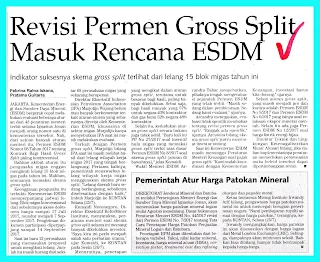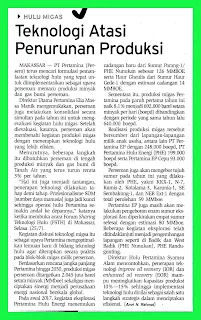Report From Houston
Sylvia Shirley Malinton complained of the heat. Whereas the popular Gita Cinta singer from high school in the early 1980s was already 1.5 years living in Houston, Texas, United States, and felt the weather city of 2.2 million people on Monday (24/7) is very missed.
"This temperature is 110 degrees [Fahrenheit]. Very hot, let alone very high humidity air, about 80% become hot. Want to enter the AC room alone if so, "said Executive Officer of the Consul General of the Republic of Indonesia in Houston. Shirley is now a career diplomat chosen by her not to be a singer and movie star. These days, he is busy accompanying the group of Energy and Mineral Resources Minister Ignasius Jonan to visit a number of multinational corporations engaged in mining, oil, and gas.
Jonan's first visit schedule with his entourage, Monday, is the headquarters of ConocoPhillips oil company. Then they went on goodwill to General Electric's Baker Hughes oil service company.
In ConocoPhillips, Jonan, who was welcomed by Chairman and CEO Ryan Lance, negotiated a contract on oil and gas field management that would end as South Jambi Block (January 2020). Tuesday morning Jonan visits Chevron and will be accepted by Mary Boroughs, President of Chevron Environment Management Company.
After that in the evening-Wednesday morning Jakarta time, EMR Minister with entourage invited to dinner with Chief Executive Officer Freeport McMoran Richard Adkerson. In a way, Richard Adkerson's dinner invitation was quite sudden. Jonan could not meet the dinner invitation for having to attend dinner with Exxon executives.
The Indonesian delegation who attended the dinner with Freeport was led by Director General of Mineral & Coal Bambang Gatot Anyono. Director of the Central Authority and International Law of the Ministry of Justice and Human Rights Cahyo R. Muzhar also participated in the meeting. He is one of the keys to the Indonesian government if it is forced to meet with Freeport in the international arbitration tribunal. Reportedly, two Cahyo staff met a number of lawyers in Houston since the beginning of this week pending a meeting with Freeport. Actually, since from Jakarta, Jonan is scheduled to hold a breakfast meeting on Wednesday (26/7).
From its name, dinner and breakfast were very informal, although both sides have been involved in such hot talks since early 2017. Why not? Meeting with oil companies like ConocoPhillips, Chevron, ExxonMobil, Baker Hughes, Schlumberger is definitely something crucial. Moreover, the government has just changed the pattern of oil exploration cooperation into a royalty-based gross split scheme from previous cost recovery-cost-based schemes issued by contractors.
However, it can not be denied that meeting with Freeport is the most eagerly awaited public. Moreover, the warming up of this negotiation has been going on for a long time, even had time to circulate information that the Indonesian government has approved the extension scheme of cooperation with Freeport, but later denied.
Houston is as hot as heating up the growing rumors in Jakarta about the meeting. The situation became even more hectic after the union claimed 4,000 Freeport Indonesia workers claimed to extend the strike agenda. In the company's version of the mine, the strike employees are considered to have resigned.
Bisnis Indonesia, the only media invited in this working visit, also felt the atmosphere of inmost member of the delegation. Of course, I ask Jonan, is this a meeting that determines the fate of Indonesian-Freeport business cooperation?
He replied; No! "This is a return visit after Richard Adkerson met me four times in Jakarta. I think, as a courtesy in business, meeting him in Houston is a good thing. "
Jonan insists, until now that he has dinner and breakfast with Richard, the negotiating position has not changed much.
"This is part of the path of a negotiation. Of course, the final decision will be obtained after both sides agree on four important issues related to the negotiations. "
The four crucial issues are the continuation of operations, construction of smelter facilities, divestment of shares, and fiscal provisions.
"Without the two parties agreeing on these four issues, it is not possible to say this negotiation is declared over. Actually, the return of the two parties to the negotiating table is a step forward. Especially after Richard in February 2017 threatened to bring a dispute to the international arbitration tribunal that Jonan immediately met with the imagery of Freeport that he thought 'elephant' turned out to be a 'cow', concerning the company's contribution to Indonesia.
However, the hot atmosphere slowly subsided after PT Freeport Indonesia President Chappy Hakim resigned and Richard returned to his country. Freeport vacated the position of President Director and recruited Tony Wenas as Executive Vice President, a former employee who served as President Director of PT International Nickel Indonesia Tbk-now PT Vale Indonesia Tbk-and President Director of PT Riau Andalas Pulp & Paper
Tony's calm nature, perhaps contributing to the cool atmosphere, as well as the willingness of the two parties to ease the atmosphere back to the business principle of win-win solutions.
On several occasions, the executive said that the talks were positive. To find out more, I met Tony since I was in Jakarta. Tuesday, at the St. Regis Hotel, Houston, he agreed with Jonan that this meeting was a groove The right to reach a negotiated agreement.
"So there is no final agreement on four crucial things."
He stated that Freeport's meeting with the Indonesian government in the United States became a further innovation.
"Thus we can achieve our goals in terms of contract extension and investment certainty together. Meanwhile, the Government can also fulfill some of its wishes. "
Then, how can the dinner-breakfast diplomacy between Jonan-Richard who starts this afternoon? Of course very thrilling. Could be, it resembles the lyrics of Gita Cinta song from Shirley Marlinton High School; "I'm looking for a happy slit, in the middle of a thorny path".
IN INDONESIA
Diplomasi Dinner-Breakfast Sengketa Freeport
Sylvia Shirley Marlinton mengeluh kepanasan. Padahal pelantun lagu Gita Cinta dari SMA yang populer pada awal 1980-an itu sudah 1,5 tahun tinggal di Houston, Texas, Amerika Serikat, dan merasa cuaca kota berpenduduk 2,2 juta jiwa tersebut pada Senin (24/7) sangat kelewatan.
“ini suhunya 110 derajat [Fahrenheit]. Panas sekali, apalagi kelembaban udara sangat tinggi, sekitar 80% yang menjadi tambah panas. Ingin-nya masuk ruang AC saja kalau begini,” tutur Pelaksana Tugas Konsul Jenderal Republik Indonesia di Houston itu. Shirley sekarang adalah seorang diplomat karier yang dipilihnya setelah tidak jadi penyanyi dan bintang film. Hari-hari ini, dia sedang sibuk mendampingi rombongan Menteri Energi dan Sumber Daya Mineral (ESDM) Ignasius Jonan melakukan kunjungan kerja ke sejumlah korporasi multinasional yang bergerak dalam pertambangan, minyak, dan gas.
Jadwal kunjungan pertama Jonan beserta rombongan, Senin, adalah ke kantor pusat perusahaan minyak ConocoPhilllips. Kemudian mereka melanjutkan muhibah ke perusahaan servis perminyakan Baker Hughes milik General Electric.
Di ConocoPhillips, Jonan yang diterima Chairman dan CEO Ryan Lance merundingkan soal kontrak pengelolaan lapangan migas yang akan berakhir seperti Blok South Jambi (Januari 2020). Selasa pagi Jonan mengunjungi Chevron dan akan diterima oleh Mary Boroughs, President Chevron Environment Management Company.
Setelah itu pada malamnya-Rabu pagi waktu Jakarta, Menteri ESDM bersama rombongan diundang makan malam dengan Chief Executive Officer Freeport McMoran Richard Adkerson. Bisa dibilang, undangan dinner Richard Adkerson cukup mendadak. Jonan tidak bisa memenuhi undangan dinner itu karena harus menghadiri makan malam bersama eksekutif Exxon.
Delegasi Indonesia yang hadir dalam dinner dengan Freeport dipimpin oleh Direktur Jenderal Mineral & Batubara Bambang Gatot Anyono. Direktur Otorita Pusat dan Hukum Internasional Kementerian Hukum dan Hak Asasi Manusia Cahyo R. Muzhar juga ikut serta dalam pertemuan itu. Dia adalah salah satu kunci bagi pemerintah Indonesia jika terpaksa bertemu dengan Freeport di peradilan arbitrase internasional. Kabarnya, dua staf Cahyo menemui sejumlah lawyer di Houston sejak awal pekan ini sambil menunggu jadwal pertemuan dengan Freeport. Sebenarnya, sejak dari Jakarta, Jonan dijadwalkan hanya menggelar breakfast meeting pada Rabu (26/7).
Dari namanya, makan malam dan sarapan terasa sangat informal, kendati kedua pihak telah terlibat dalam perundingan yang begitu panas sejak awal 2017. Betapa tidak? Pertemuan dengan perusahaan minyak seperti ConocoPhilips, Chevron, ExxonMobil, Baker Hughes, Schlumberger jelas sesuatu yang krusial. Apalagi pemerintah baru saja mengubah pola kerja sama eksplorasi minyak menjadi skema gross split berpatokan rolyalti dari sebelumnya cost recovery-skema berbasis biaya yang dikeluarkan kontraktor.
Namun, tidak bisa dipungkiri, pertemuan dengan Freeport adalah yang paling ditunggu-tunggu publik. Apalagi pemanasan dari negosiasi ini sudah berlangsung lama, bahkan sempat beredar informasi bahwa pemerintah Indonesia telah menyetujui skema perpanjangan kerja sama dengan Freeport, tetapi kemudian dibantah.
Houston yang panas seperti semakin memanaskan rumor yang berkembang di Jakarta ihwal pertemuan tersebut. Keadaan semakin riuh setelah serikat pekerja mengklaim 4.000 pekerja Freeport Indonesia menyatakan memperpanjang agenda mogok kerja. Dalam versi perusahaan tambang tersebut, para karyawan pelaku mogok sudah dianggap mengundurkan diri.
Bisnis Indonesia, satu-satunya media yang diundang dalam kunjungan kerja ini, turut merasakan suasana kebatinan anggota delegasi. Tentu saja, saya bertanya kepada Jonan, apakah ini merupakan pertemuan yang menentukan nasib kerja sama bisnis Indonesia-Freeport?
Dia menjawab; Tidak! “Ini adalah kunjungan balasan, setelah Richard Adkerson empat kali menemui saya di Jakarta. Saya rasa, sebagai sebuah sopan santun dalam berbisnis, menemuinya di Houston adalah suatu yang baik.”
Jonan menegaskan, sampai saat ini hingga dia makan malam dan sarapan dengan Richard, posisi negosiasi belum berubah banyak.
“Ini adalah bagian alur dari sebuah negosiasi. Tentu saja keputusan akhir akan didapatkan setelah kedua pihak sepakat dengan empat isu penting terkait perundingan.”
Keempat isu krusial tersebut adalah kelanjutan operasi, pembangunan fasilitas pemurnian (smelter), divestasi saham, dan ketentuan fiskal.
“Tanpa kedua pihak sepakat dengan empat isu tersebut, maka belum bisa dibilang perundingan ini dinyatakan selesai. Sebenarnya, kembalinya dua pihak ke meja perundingan merupakan langkah maju. Apalagi setelah Richard pada Februari 2017 mengancam akan membawa perselisihan ke peradilan arbitrase internasional yang segera dibalas Jonan dengan perumpamaan Freeport yang dikiranya ‘gajah’ ternyata adalah ‘sapi’, menyangkut kontribusi perusahaan itu terhadap Indonesia.
Namun, suasana panas tersebut perlahan mereda setelah Presiden PT Freeport Indonesia Chappy Hakim mengundurkan diri dan Richard kembali ke negaranya. Freeport lalu mengosongkan posisi Presiden Direktur dan merekrut Tony Wenas sebagai Executive Vice President, mantan karyawan yang sempat berkarier sebagai direktur utama PT International Nickel Indonesia Tbk-kini PT Vale Indonesia Tbk-dan Presiden Direktur PT Riau Andalas Pulp & Paper
Pembawaan Tony yang tenang, barangkali turut membuat suasana sejuk, di samping kemauan dua pihak untuk meredakan suasana kembali kepada prinsip bisnis win-win solutions.
Dalam beberapa kesempatan, eksekutif tersebut mengatakan bahwa perundingan berlangsung positif. Untuk tahu lebih jauh, saya menemui Tony sejak masih di Jakarta. Selasa, di Hotel St Regis, Houston, dia sepakat dengan Jonan bahwa pertemuan ini adalah alur yang benar untuk mencapai kesepakatan negosiasi.
“Jadi memang belum ada kesepakatan final menyangkut empat hal krusial.”
Dia menyatakan pertemuan Freeport dengan pemerintah Indonesia di Amerika Serikat menjadi inovasi lanjutan.
“Dengan demikian kami bisa mencapai tujuan kami dalam hal perpanjangan kontrak sekaligus kepastian investasi secara bersama-sama. Sementara itu, Pemerintah juga bisa memenuhi sejumlah keinginannya.”
Lalu, bagaimana hasil diplomasi makan malam-sarapan antara Jonan-Richard yang dimulai siang ini? Tentu saja sangat mendebarkan. Bisa-bisa, ini mirip syair lagu Gita Cinta dari SMA Shirley Malinton; "kini kucari celah bahagia, di tengah jalan yang penuh duri".
Bisnis Indonesia, Page-1, Wednesday, July 26, 2017










